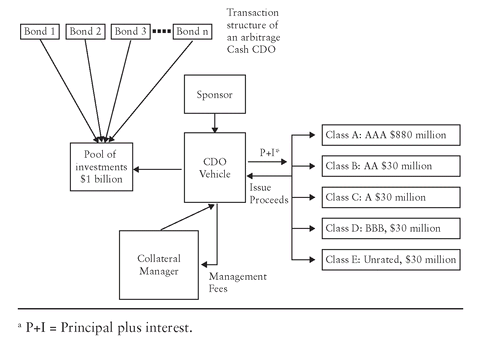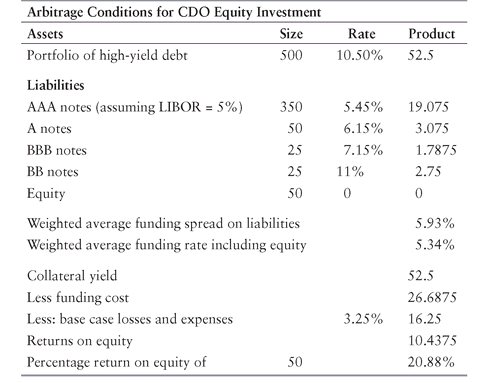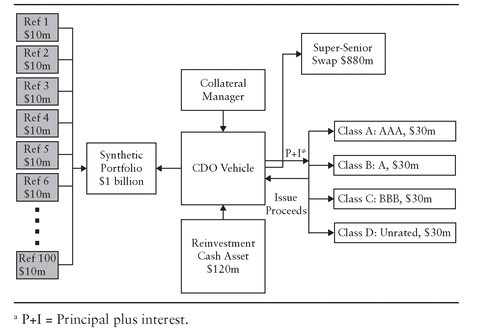ARBITRAGE CDOs
Making use of the technology provided by traditional asset-backed securitizations, but with the motivation to generate arbitrage opportunities provided by perceived inefficient pricing of securities, particularly high-yield securities, there emerged in the market a new class of securitization product—arbitrage CDOs. Early examples of arbitrage CDOs are JPMorgan’s BISTRO and Citibank’s C*Star.
As noted earlier, the term “arbitrage” is loosely used. It does not have the same meaning in finance. Arbitrage in the sense used here means trying to capture via active management the spread between the return on assets and funding costs. In the early stages of the arbitrage CDO market, the collateral used was high-yield corporate debt. This asset class was selected because of what was thought to be significant arbitrage opportunities provided by the difference between implied default rates and expected default rates on high-yield corporate debt. The implied default rate is inherent in the pricing of the debt, whereas the expected default rate is based on the probability distribution of the downgrade of a particular rating. If the implied default rate is higher, there is an opportunity to make a profit.
Besides, the pooling process creates the source of profit—arbitrage CDOs are based on the underlying principle of modern portfolio theory as formulated by Markowitz: If there are n risks that are less than positively perfectly correlated and those risks are aggregated in a portfolio, the portfolio risk is less than the sum of the individual risks.
The purpose of an arbitrage CDO is not to liquidate the assets held on the balance sheet of the originator, but to accumulate assets from proceeds of the CDO to make an arbitrage profit. Arbitrage CDOs can be issued by anyone, but most typically are issued by investment banks, investment management boutiques, asset managers, and the like. Some arbitrage transactions are sector-specific such as real estate investments, and are obviously issued by managers having special expertise in the particular sector.
Arbitrage CDOs may be either in cash form or synthetic form, discussed below.
Arbitrage Cash CDOs
The steps in creating an arbitrage cash CDOs are as follows:
• The sponsor who puts the whole show together first starts to line up investors who are likely to invest in the CDO. Of crucial importance is the equity investor, as the entire structure is a kind of inverted pyramid with the equity tranche at the bottom. The typical equity investors are hedge funds, private equity funds or high-net-worth individuals looking for a yield kicker.
• Based on the investors’ returns/risk requirements and investible funds, a possible portfolio size and composition is outlined. The entire portfolio does not have to be ramped up at the time of taking the deal to the market—typically, CDOs do allow a ramp-up period within which to invest the funding raised in acquiring assets.
• Based on the risk attributes of the already ramped and to-be-ramped-up assets (say, adding up to $1 billion), we draw a probability distribution for the pool. Let us suppose the model comes up with a distribution suggesting that with a credit enhancement of 3%, it may be possible to get a rating of BBB, while a credit support of 6% may be enough to get an A rating. Similarly, the required enhancement levels for AA rating and AAA ratings are worked out as 9% and 12%, respectively.
• An SPV is created.
• The SPV raises cash worth $1 billion, of which 3% comes from the equity investors.
• A collateral manager is appointed to select the assets both at inception and on ongoing basis over time.
• With this cash, the collateral manager buys the pool worth $1 billion (inclusive of cash collateral).
• Since at inception the loans in the pool will obviously carry a weighted average interest that exceeds the weighted average funding cost of the transaction plus the collateral manager’s fees and other expenses, there will be an excess spread. The excess spread will also be available to absorb expected losses in the pool.
The transaction structure is shown in Figure 12.3.
Legal Structure
Questions such as true sale that confront balance sheet cash transactions are not important in the case of arbitrage transactions. Quite obviously, the CDO is buying assets from the market, and not from the equity investors. There is no originator-enhancement in the transaction, nor is the originator controlling servicing or excess profits from the assets.
Underlying Assets
As the objective of an arbitrage transaction is to generate higher spreads, the selection of assets is done so as to capitalize on perceived pricing inefficiencies. As discussed earlier, the motivation is clearly to select assets where, for a given rating, the returns are higher. To control the motivation of the manager to make investment decisions that would impair the quality of the portfolio, rating agencies put a limit on weighted average rating (as measured by a weighted average factor formula by a rating agency), weighted average spreads, and other actions of the manager.
pricing inefficiencies. As discussed earlier, the motivation is clearly to select assets where, for a given rating, the returns are higher. To control the motivation of the manager to make investment decisions that would impair the quality of the portfolio, rating agencies put a limit on weighted average rating (as measured by a weighted average factor formula by a rating agency), weighted average spreads, and other actions of the manager.
FIGURE 12.3 Arbitrage Cash CDO

Because the idea underlying an arbitrage CDOs is to maximize returns, there is a natural motivation to acquire positions in structured finance securities, particularly at lower rated levels which provided the opportunity to generate much higher spreads compared to like-rated corporate bonds. This resulted in the popularity of structured finance CDOs that we will discuss later in this chapter.
Reinvestment Period
Given the objective of an arbitrage CDO, it is quite obvious that the CDO will be a reinvesting transaction. The manager seeks not to distribute principal payments to investors in order to continue to use those funds to generate interest in excess of the funding cost.
For that reason, the reinvesting structure is the most common structure in the case of arbitrage CDOs. As is typical with any reinvesting-type transaction, there are tests to be satisfied before the manager may be permitted to reinvest—essentially asset coverage or OC trigger, and income or IC trigger. These tests are discussed later in Chapter 13.
Credit Enhancement Structure
The credit enhancement structure for arbitrage CDOs is similar to that of a balance sheet CDO, except that there is no originator-provided enhancement; instead, the juniormost class is commonly referred to as equity class.
Illustration of Potential Returns from Arbitrage CDOs
The illustration in Table 12.1 shows the returns on equity of a putative CDO. We have taken the size of the CDO as $500 million, invested in high-yield debt instruments yielding 10.5%. The liability structure and the costs of the liabilities are obvious in the example. We have also assumed that there will be expenses and annual losses in the pool that add up to 3.25%. As can be seen in the table, the return on equity is 20.88% based on the assumptions made in the table.
TABLE 12.1 Returns from a Hypothetical Arbitrage CDO

Arbitrage Synthetic CDOs
While the purpose of arbitrage synthetic CDOs is the same as for an arbitrage cash CDO, the assets are acquired not in cash but in synthetic form.
Creating an Arbitrage Synthetic CDO
The steps in the creation of an arbitrage synthetic CDO are as follows: 
• The assets of the CDO are synthetic assets. This means that protection is sold with respect to specific reference entities. As with a loan or a bond being a credit exposure to the obligor, the protection sold on a reference entity is an exposure to that entity and, therefore, economically equivalent to a long position is the reference entity. Each such protection sold with respect to a reference entity will have a notional value. For example, let us say we have 100 such credit default swaps, with a notional value of $10 million each, adding up to $1 billion. It is notable that typically the notional value for each reference entity in an arbitrage synthetic CDO will be the same. This allows ease of modeling.
• The process of lining up investors is the same as in case of an arbitrage cash CDO discussed earlier. However, most notably, the amount of actual funding needed on a notional pool of $1 billion, will only be a fraction, as discussed below.
• Based on the risk attributes of the notional pool, we draw a probability distribution for the pool. Let us suppose the model indicates that there is very little (say, 0.001%) probability of losses in the pool exceeding 12%. If so, the CDO may raise funding of only 12%, and enter into a super-senior swap for the balance of 88% on an unfunded basis.
• In the 12% funding size, we assume four classes of liabilities, each with a size of 3% with ratings of AAA, A, BBB, and unrated, respectively.
• An SPV is created.
• The SPV raises cash worth $120 million, which is reinvested in very high quality assets.
• A collateral manager is appointed to select the assets both at inception and on ongoing basis over time.
• During the ramp-up period, the collateral manager sells protection to one or more protection buyers (normally the sponsoring bank may be a protection buyer) with reference to the 100 reference entities.
• The income of the CDO will be (1) the premium earned from the selling of protection on the 100 credit default swaps; and (2) income on the investment in the collateral worth $ 120 million. This income should be enough to pay (1) the collateral manager’s fees and other expenses of the CDO; (2) the super senior swap premium; and (3) weighted average coupons to the investors, including any differential returns for the equity investor.
FIGURE 12.4 Arbitrage Synthetic CDO

• If there are losses on the credit default swaps, which require the CDO to pay compensation to the respective protection buyer, the CDO will sell the collateral to the extent required and would simultaneously write off Class D.
Figure 12.4 illustrates the transaction structure.
..................Content has been hidden....................
You can't read the all page of ebook, please click here login for view all page.
